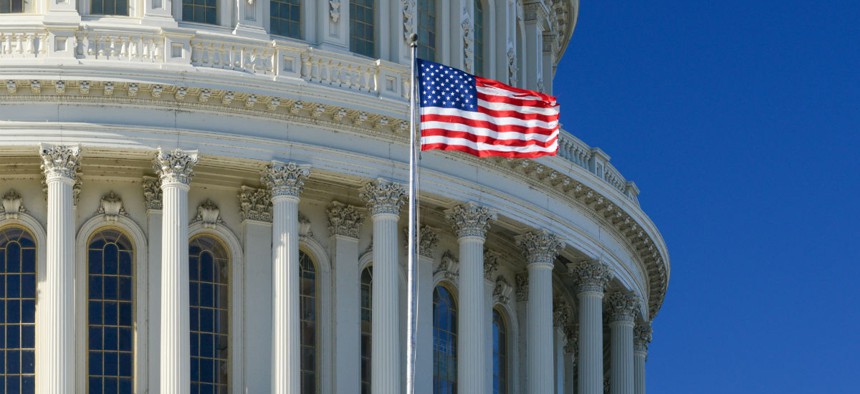Nine Major Agency Reform Proposals in the House GOP Budget
Eliminating programs, restructuring agency components, streamlining hiring and more.
House Republicans on Tuesday issued their budget blueprint for fiscal 2018, proposing a $5 billion cut next year at non-defense agencies and a total of $1.3 trillion in reductions in domestic spending over the next 10 years.
Lawmakers pitched a slew of governmentwide and individual agency reforms, including familiar targets such as improper payments, duplicative programs and constraining bureaucracy. By fiscal 2027, non-defense agencies would face a collective cut of 18 percent from current spending levels and 34 percent from the Congressional Budget Office’s projected top-line appropriation. Defense spending would increase by $929 billion over the current caps during the next 10 years.
Congressional appropriators, rather than the budget panel, will ultimately set the spending levels at individual agencies. Additionally, adjusting the current spending caps will require some Democratic support to get through the Senate. The blueprint is consequential, however, in that it eases the passage of some reforms through reconciliation instructions and sets the legislative agenda for the majority party.
Here is a look at some of the major reforms proposed in the GOP budget:
- Program elimination: The budget document identified 92 anti-poverty programs Republicans on the House Budget Committee found duplicative, with savings totaling $843 billion. The programs are run out of the departments of Veterans Affairs, Energy, Labor and others.
- Improper payments: House Republicans optimistically projected $700 billion in savings by reducing improper payments. That is half the total of the wrongful expenditures the committee estimated will exist over the next decade. It would launch a “special commission” tasked with “finding ways to tangibly reduce” the payments. “This timeframe recognizes that this problem is complex, and there is not a silver-bullet solution that could be implemented overnight,” the lawmakers wrote. This commission should methodically solicit input from experts within government, such as the Government Accountability Office, and the private sector to determine the best ways to tackle this problem.
- VA workforce: House Republicans said their budget would solve “mismanagement and lack of accountability” at the Veterans Affairs Department, saying it has “suffered from a growing bureaucracy.” On workforce issues, the measure would direct VA to trim layers of middle management, cut management overall, streamline the disciplinary and hiring processes and modify performance metrics. It would fully fund Trump’s request for a 6 percent spending increase in fiscal 2018 and encourage a “national dialogue” to determine the path forward for delivering health care to veterans.
- DHS hiring: President Trump has prioritized boosting the Customs and Border Protection and Immigration and Customs Enforcement workforces, and House Republicans are eager to comply. The lawmakers said their budget would enable CBP and ICE to “recruit, train and deploy agents necessary to increase our nation’s operational security.” Trump has suggested hiring 15,500 new agents and officers and appropriators have proposed a down payment on that request in fiscal 2018. On another major campaign promise, the budget committee issued a more lukewarm response. “Border wall funding is also included in this budget through various Department of Homeland Security construction accounts to not only construct new fencing and replace ineffective fencing and barriers, but also to establish forward operating bases and surveillance technology along our southern border,” the lawmakers said.
- Bringing USPS on budget: As an independent, self-funded federal agency, the U.S. Postal Service is considered for appropriations purposes “off budget.” The House blueprint would change that, bringing the mailing agency back on budget for the first time since 1989. In a 2009 report, the USPS inspector general said administrations in the 1970s and 1980s brought the Postal Service on and off budget depending on whether the agency was running a deficit or surplus. When on budget, the IG said, USPS was “commonly caught up in deficit reduction squabbles, and took on obligations belonging to the Treasury.”
- Gutting EPA: If Congress implements House appropriators’ fiscal 2018 plan, then the Environmental Protection Agency will have seen its budget slashed by 27 percent since 2010. The budget proposal would continue that trajectory, suggesting ongoing spending cuts to restrict “its unprecedented activity [on] regulatory policy” and eliminate the Office of Regulatory Policy and Management. It would seek to slash overlapping climate change research conducted at both EPA and the National Oceanic and Atmospheric Administration.
- Privatization: The budget assumes the privatization of the government-controlled mortgage backers Fannie Mae and Freddie Mac.
- Refocusing the Energy Department: Energy, the lawmakers said, should focus on three things: maintaining the national nuclear supply, environmental cleanup and basic research into discovery science and energy security. The budget, therefore, would reduce funding for commercial research and development, slash spending on green energy programs and eliminate the loan guarantee program.
- Restructuring Commerce: To date, House Republicans said, the government’s “solution for every problem involves more money, more red tape, and more bureaucracy.” To shift that trend, their budget would cut programs designed to assist American business they identified as “corporate welfare,” move NOAA to the Interior Department, establish the Patent and Trademark Office as an independent agency, transfer the Census Bureau to the Labor Department’s Bureau of Labor Statistics and eliminate or consolidate about 10 other agencies.
For coverage of the pay and benefits proposals in the House budget, click here.








